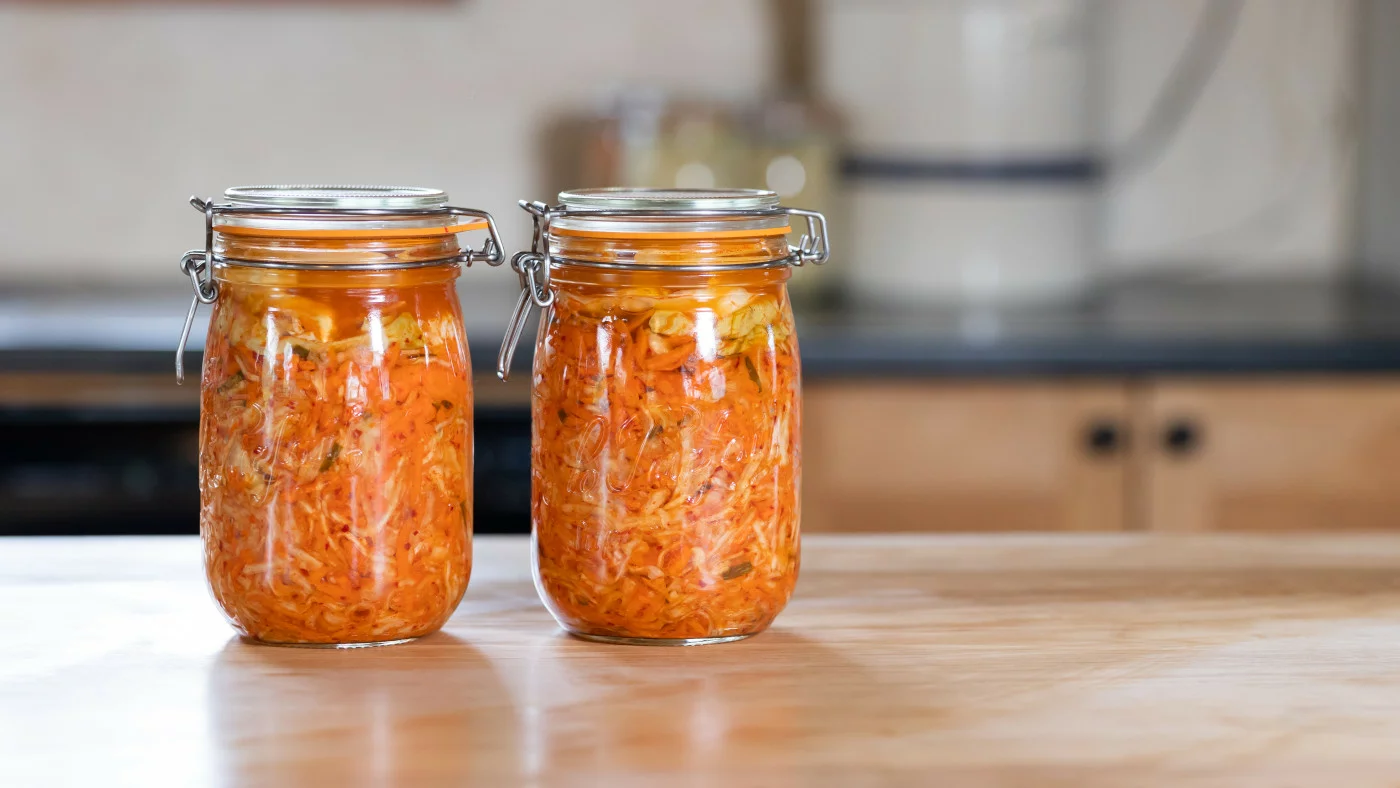
Kimchi, a staple of Korean cuisine, is more than just a flavorful side dish; it is a complex mixture of fermented vegetables that offers numerous health benefits. Primarily made from napa cabbage and radishes, kimchi is seasoned with an array of spices, including garlic, ginger, and chili pepper, and often includes fish sauce or fermented shrimp for added depth of flavor. The fermentation process is where the magic happens, transforming raw ingredients into a tangy, probiotic-rich food that supports gut health and overall well-being. This article delves deeper into the science behind kimchi fermentation, its health benefits, cultural significance, and practical applications in modern diets, aiming to provide knowledge inside of this iconic dish.
The Fermentation Process

1. Ingredients and Preparation
The preparation of kimchi begins with selecting high-quality ingredients. The primary components include:
- Napa Cabbage: This leafy vegetable is the heart of most kimchi recipes. Its crisp texture and ability to absorb flavors make it ideal for fermentation.
- Radishes: Commonly used varieties include Korean radish (mu) and daikon. These add crunch and a slightly peppery flavor to the mix.
- Seasonings: A combination of garlic, ginger, chili powder (gochugaru), sugar, and fish sauce or salted shrimp (saeujeot) enhances the flavor profile and aids in fermentation.
The process starts with salting the cabbage, which draws out moisture and creates a brine. This step is crucial as it helps to inhibit harmful bacteria while promoting the growth of beneficial lactic acid bacteria (LAB). The salted cabbage is then mixed with the seasoning paste and packed into jars or containers, where fermentation occurs.
2. Role of Lactic Acid Bacteria
Lactic acid bacteria play a pivotal role in the fermentation of kimchi. These microorganisms are naturally present on the surface of vegetables and in the environment. As fermentation begins, LAB convert sugars in the vegetables into lactic acid, which serves multiple purposes:
- Preservation: The increase in acidity inhibits the growth of spoilage organisms, allowing kimchi to be stored for extended periods without refrigeration.
- Flavor Development: The lactic acid produced during fermentation contributes to the characteristic tangy flavor of kimchi. Additionally, LAB produce other compounds that enhance the overall taste, including esters and carbonyls, which contribute to the complexity of flavors.
3. Enzymatic Changes
Fermentation is not just a microbial process; it also involves various enzymatic reactions that transform the ingredients:
- Proteolysis: Enzymes break down proteins into amino acids, which enhance the umami flavor of kimchi. This process is particularly important for the development of savory notes that make kimchi so appealing.
- Lipolysis: The breakdown of fats can lead to the formation of free fatty acids, which contribute to the aroma and flavor profile of the final product.
These enzymatic changes result in a product that is not only delicious but also rich in bioactive compounds that can have health benefits.
Health Benefits of Kimchi
1. Probiotics and Gut Health
One of the most significant health benefits of kimchi is its probiotic content. Probiotics are live microorganisms that provide health benefits when consumed in adequate amounts. The main benefits include:
- Improved Digestion: Probiotics help maintain a balanced gut microbiome, which is essential for proper digestion and nutrient absorption. A healthy gut can alleviate issues such as bloating, constipation, and diarrhea.
- Enhanced Immune Function: A robust gut microbiome supports the immune system by preventing the overgrowth of harmful bacteria and pathogens. This can reduce the incidence of infections and enhance overall health.
2. Nutritional Value
Kimchi is not only low in calories but also packed with essential nutrients, making it a valuable addition to any diet:
- Vitamins and Minerals: Kimchi is rich in vitamins A, B, and C, as well as minerals like calcium and iron. These nutrients are vital for various bodily functions, including immune support, energy production, and bone health.
- Antioxidants: The fermentation process increases the levels of antioxidants in kimchi, which help combat oxidative stress and inflammation. Antioxidants play a crucial role in reducing the risk of chronic diseases such as heart disease and cancer.
3. Potential Disease Prevention
Regular consumption of kimchi has been associated with several health benefits that may contribute to disease prevention:
- Weight Management: The low-calorie content and high fiber content of kimchi can aid in weight control. Fermented foods are often linked to improved satiety, helping individuals feel full longer.
- Chronic Disease Reduction: Some studies suggest that diets rich in fermented foods, including kimchi, may lower the risk of chronic diseases such as type 2 diabetes, cardiovascular disease, and certain cancers. The anti-inflammatory properties of kimchi may play a role in these protective effects.
4. Mental Health Benefits
Growing evidence highlights a link between gut health and mental well-being, a relationship commonly known as the gut-brain axis. The probiotics found in kimchi may help enhance mood and support cognitive function. Research indicates that maintaining a balanced gut microbiome can affect the production of neurotransmitters like serotonin—an essential chemical for mood regulation.
Cultural Significance
1. Traditional Practices
Kimchi is deeply embedded in Korean culture and is often considered the national dish. The practice of making kimchi, known as “kimjang,” is a communal activity that brings families and communities together. Traditionally, kimjang occurs in late fall, when cabbage is in season, and involves preparing large quantities of kimchi to be stored for the winter months. This practice not only preserves food but also strengthens social bonds and cultural identity.
2. Global Popularity
In recent years, kimchi has gained international recognition, appreciated for its unique flavor and health benefits. As global interest in fermented foods has surged, kimchi has found its way into various cuisines worldwide. It is often featured in fusion dishes, such as kimchi tacos, kimchi fried rice, and even kimchi burgers. This globalization of kimchi reflects a broader trend of incorporating traditional foods into modern diets, promoting cultural exchange and culinary innovation.
Practical Applications in Modern Diets
1. Incorporating Kimchi into Meals
For those looking to reap the health benefits of kimchi, incorporating it into daily meals can be simple and delicious. Here are some ideas:
- As a Side Dish: Serve kimchi alongside rice, grilled meats, or fish for a traditional Korean meal.
- In Salads: Add kimchi to salads for an extra crunch and a burst of flavor. It pairs well with leafy greens, avocado, and sesame dressing.
- In Soups and Stews: Kimchi can be added to soups and stews, such as kimchi jjigae (kimchi stew), enhancing the dish’s flavor and nutritional value.
- On Sandwiches and Wraps: Use kimchi as a topping for sandwiches or wraps, adding a spicy and tangy kick to your lunch.
2. Homemade Kimchi
Making kimchi at home can be a rewarding experience. Not only does it allow for customization of flavors and ingredients, but it also ensures that you have a fresh and probiotic-rich product. Here’s a basic recipe to get started:
Basic Kimchi Recipe
Ingredients:
- 1 medium napa cabbage
- 1/2 cup sea salt
- 4 cups water
- 1 tablespoon grated ginger
- 1 tablespoon minced garlic
- 1 tablespoon sugar
- 1/4 cup fish sauce (or soy sauce for a vegetarian option)
- 1/2 cup gochugaru (Korean red pepper flakes)
- 2 radishes, julienned
- 4 green onions, chopped
Instructions:
- Prepare the Cabbage: Cut the napa cabbage into quarters and remove the core. Dissolve the sea salt in water and soak the cabbage in the brine for 2-4 hours, turning occasionally.
- Make the Paste: In a bowl, combine ginger, garlic, sugar, fish sauce, and gochugaru to form a paste.
- Mix Ingredients: Drain the cabbage and rinse it under cold water. In a large bowl, combine the cabbage, radishes, green onions, and spice paste. Mix thoroughly, ensuring the cabbage is well-coated.
- Pack and Ferment: Firmly pack the mixture into sterilized jars, making sure to leave a bit of headspace to allow for expansion during fermentation. Seal the jars and let them sit at room temperature for 1 to 5 days, depending on how tangy you like it. After fermentation, transfer the kimchi to the refrigerator for storage.
3. Store-Bought Options
For those who prefer convenience, many supermarkets now offer a variety of kimchi options. When purchasing store-bought kimchi, look for products that are labeled as “fermented” and contain live cultures for maximum probiotic benefits. Additionally, check the ingredient list for natural ingredients and minimal preservatives.
Conclusion
Kimchi is a remarkable food that embodies the intersection of science, health, and culture. The fermentation process not only enhances the flavor and shelf life of vegetables but also enriches them with probiotics and nutrients that support gut health and overall well-being. As we explore the knowledge inside the discussion of kimchi, we gain a deeper appreciation for its role in Korean culture and its growing popularity worldwide.
Incorporating kimchi into our diets can offer numerous health benefits and contribute to a more diverse and flavorful culinary experience. Whether enjoyed as a traditional side dish or as part of innovative fusion recipes, kimchi remains a testament to the power of fermentation and the enduring legacy of traditional foods in modern diets. As interest in gut health and fermented foods continues to rise, kimchi stands out as a delicious and nutritious option that is both beneficial and culturally significant.
Related Posts
 Green Housing: Knowledge for Sustainable Residential Development
Green Housing: Knowledge for Sustainable Residential Development
 Update IMB 2025: Izin Mendirikan Perumahan Indonesia?
Update IMB 2025: Izin Mendirikan Perumahan Indonesia?
 PBB Tahunan: Pajak Bumi & Bangunan Wajib Bayar!
PBB Tahunan: Pajak Bumi & Bangunan Wajib Bayar!
 Peran PPAT Property dalam Dunia Properti Indonesia
Peran PPAT Property dalam Dunia Properti Indonesia



